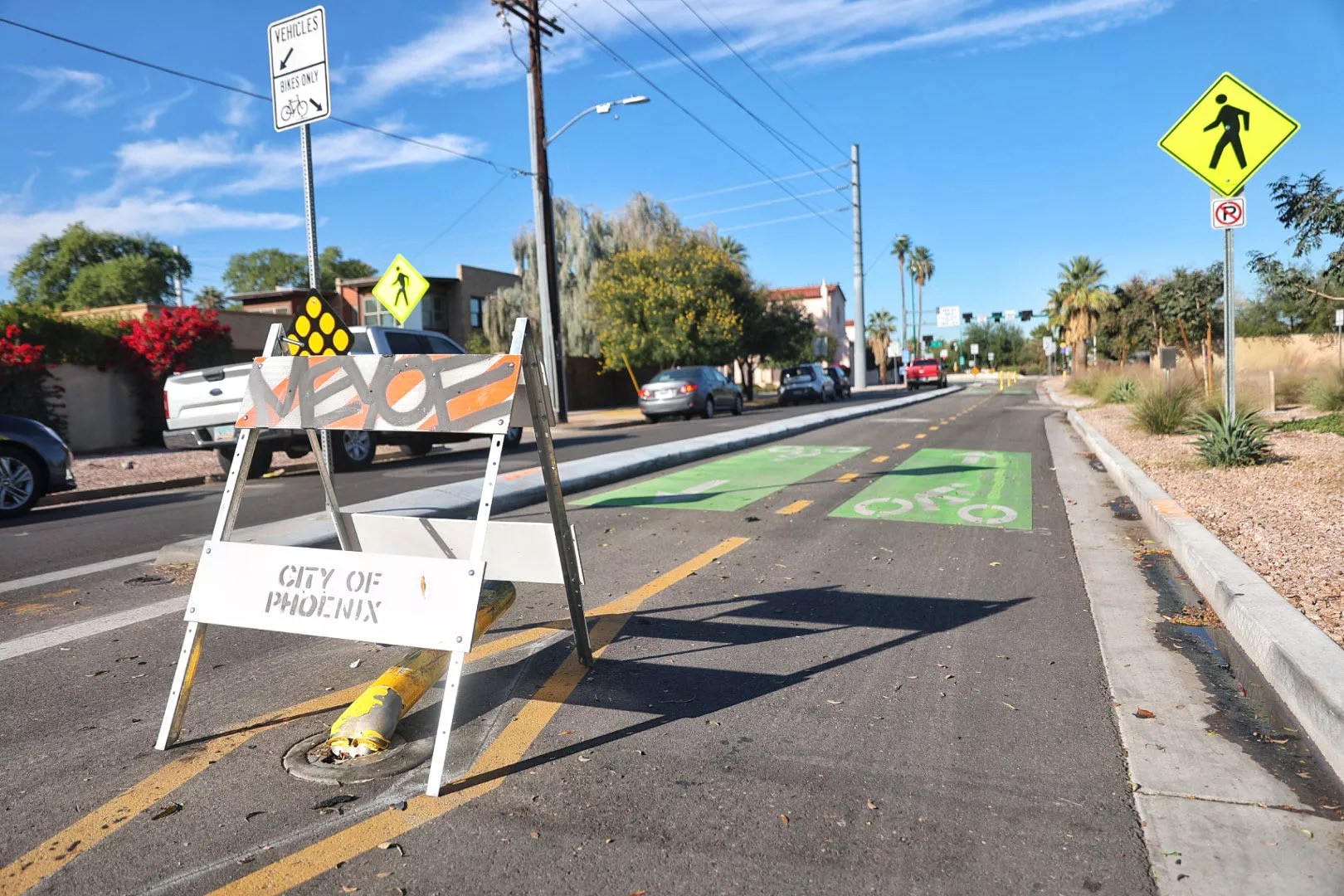
Jacob Tyler Dunn

Audio By Carbonatix
The City of Phoenix canceled plans to widen one stretch of a downtown street and instead decided to create protected bicycle lanes months after a cyclist was killed by a drunken driver there.
Supporters of the beloved cyclist consider the safety project a posthumous step towards justice for the orange-vested downtown ambassador, who was hit in late August and died a month later.
The city transportation department plans to build bicycle lanes along Fillmore Street between Central Avenue and Seventh Street which have a berm between vehicles and cyclists.
Advocates claim it’s long-overdue and say city officials have, for years, been “dragging their feet” on improving the safety of pedestrians and cyclists alike.
Will you step up to support New Times this year?
At New Times, we’re small and scrappy — and we make the most of every dollar from our supporters. Right now, we’re $15,500 away from reaching our December 31 goal of $30,000. If you’ve ever learned something new, stayed informed, or felt more connected because of New Times, now’s the time to give back.
“I’m not sure how many people have to be injured or die before we see these proposed projects actually come to fruition,” said Stacey Champion, a local community activist. “It can’t come fast enough.”
Cyclists account for nearly 6 percent of traffic fatalities in Phoenix, considered among the most dangerous cities for pedestrians, according to a U.S. Department of Transportation report.
More than 1,200 pedestrians died from vehicle crashes over a five-year stretch in Arizona. In 2017, Phoenix tallied more than 250 of those fatalities.
It’s not enough to have bicycle lanes on the road but barriers are needed, advocates argue. The cost of a bike lane is minuscule and it could mean the difference between life and death for residents in traffic, Champion said.
According to the Pedestrian and Bicycle Information Center, protected bike lanes can cost anywhere from $133,170 to $536,680 per mile.
More than 100 residents gathered to offer support for the bike lanes during the city’s community meeting on Tuesday night that involved Arizona State University, bicycle group Phoenix Spokes People, and other community groups.
“The public meeting provided our staff with meaningful feedback that will be taken into consideration during the project design process,” said city transportation department spokesperson Gregg Bach.
Support for bike lanes swelled after the death of Hans Hughes, a 43-year-old who was struck by a drunken driver near First and Fillmore Streets riding home after work on August 20. He died from his injuries on September 21.
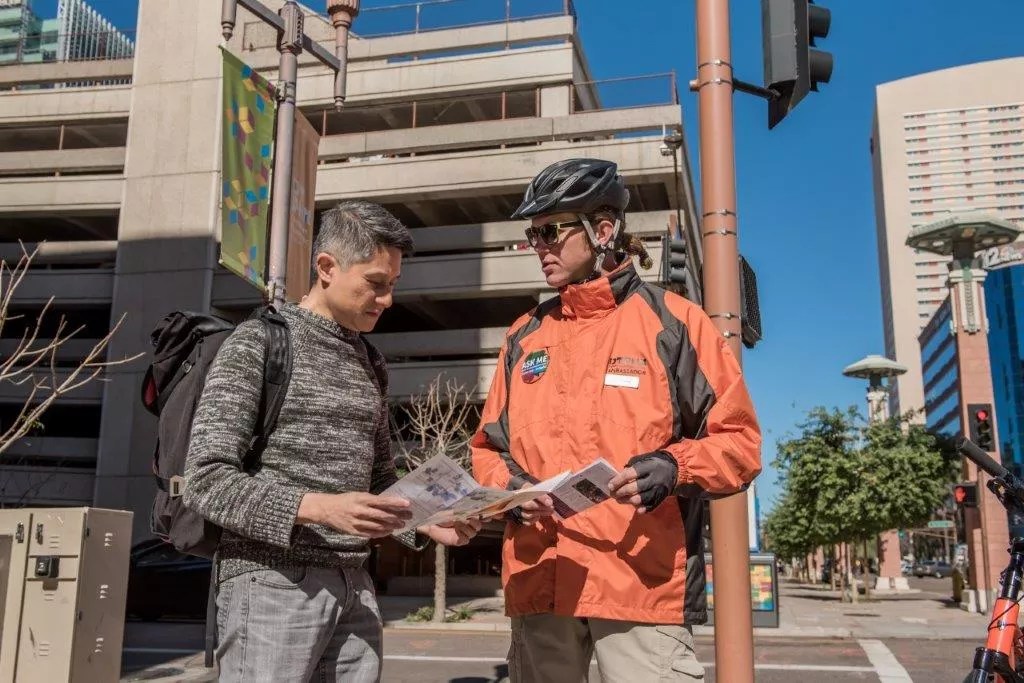
Friends, neighbors, and colleagues can hardly recall a moment when Downtown Phoenix Ambassador Hans Hughes (right) was not helping someone. Hughes was killed by a drunk driver while bicycling downtown several months ago.
Downtown Phoenix Inc.
Hughes was an ambassador for downtown Phoenix helping visitors find their way around city streets.
“It really is a reparation,” said Ryan Boyd, who serves on the Urban Phoenix Project Board of Directors, of the Fillmore project. “The thing that always haunts me is just that you wish Hans would be here to see this, instead of the cause that [necessitated] we get this done.”
R.J. Price, a former colleague of Hughes at Downtown Phoenix Inc., remembers the decedent as a “beloved member of the Downtown Phoenix community” who made an indelible impression on tens of thousands of residents, employees, students, and visitors.
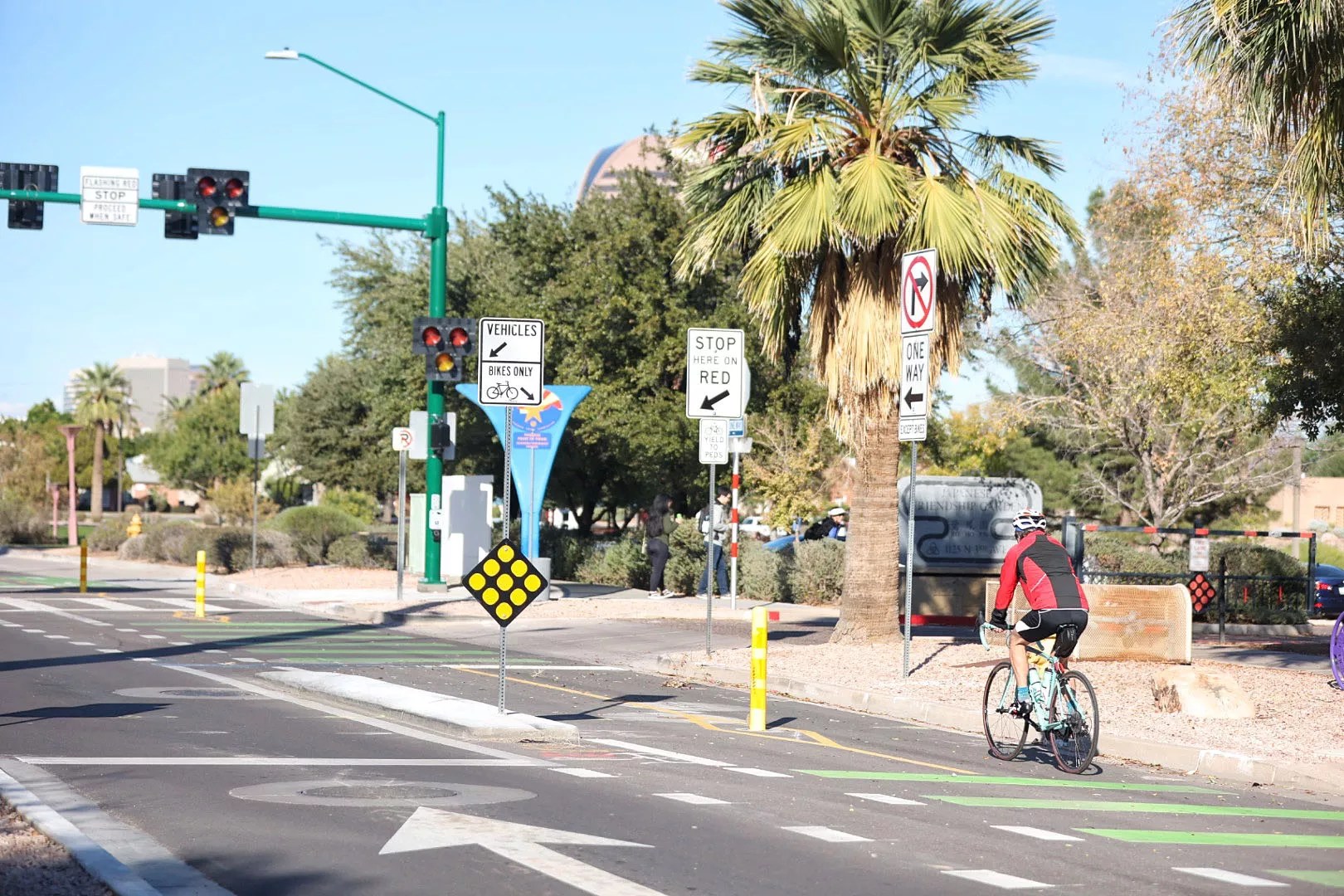
Protected bicycle lanes in Phoenix were installed in recent months.
Jacob Tyler Dunn
“Improving bicycle infrastructure in downtown and throughout Phoenix will save lives and positively impact so many,” said Price, the organization’s chief marketing officer. “It will also ensure that Hans’ tragic death isn’t in vain.”
Phoenix City Councilwoman Yassamin Ansari is an outspoken advocate for pedestrian safety in the city’s Seventh District, which extends west toward Avondale from downtown.
“We don’t know that protected bike lanes would have necessarily saved [Hughes] in this particular case, given that it happened in the intersection, [but] the reality is that bikers in our city are constantly put in danger, due to lack of protective infrastructure and clear signage,” Ansari said. “These changes may save future cyclists like Hans.”
Phoenix’s first two-way protected bicycle lanes along Third and Fifth avenues opened recently to offer a safer way to commute north and south across downtown. Still missing is a route that spans east to west.
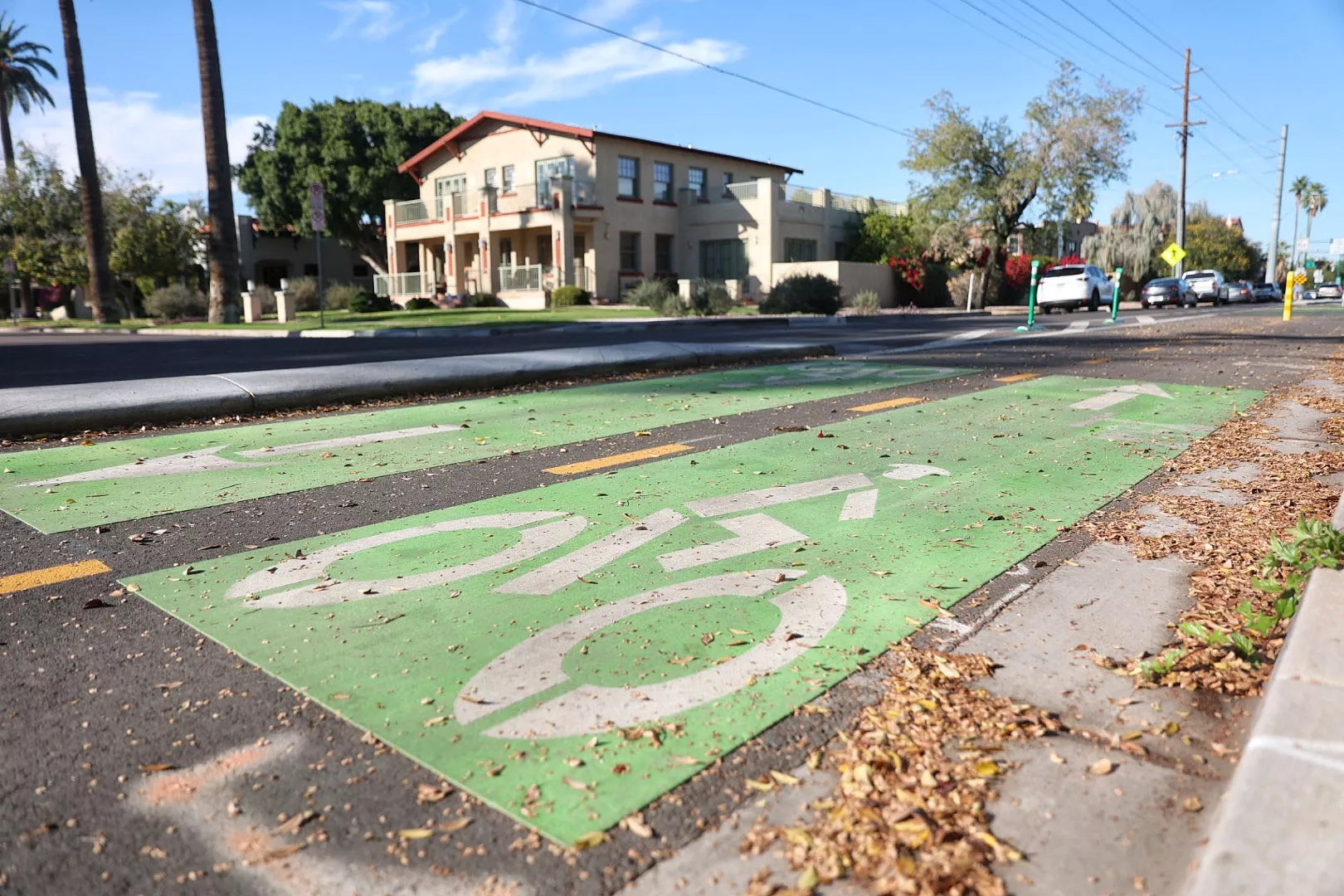
Green lanes mark bicycle lanes across Phoenix.
Jacob Tyler Dunn
The Fillmore project fills the gap but city officials are pushing to extend the bicycle lanes past Seventh Street to the east and Central Avenue to the west. The city plans to roll out more than 1,000 miles of bicycle lanes by 2050, but this section downtown is special.
“After Hans tragically died, we saw an outpouring of support and requests for protective infrastructure to make biking in Downtown Phoenix safer,” Ansari said. “People move downtown because they want to be within walking and biking distance to their jobs, to the grocery store, to bars and restaurants. This project will help make downtown more pedestrian-oriented, which is what the community here wants to see.”
If the project moves forward, work would be completed in the spring of 2022.
“The coalition of folks that supports this has grown every day,” said Boyd of Urban Phoenix. “That’s amazing to see the community really back the need for actual protection for bike lanes.”
Phoenix city officials consider the city bike-safe, despite its history and reputation nationally as a dangerous place to get around on two wheels. The city labels Fillmore a “bicycle boulevard.”
“It is kind of a laughingstock to have a bicycle boulevard with a tiny stretch of sharrows [painted markings] and no actual bike lanes,” Boyd said. “You have stronger bike protection in random parts of suburban Phoenix than on a City of Phoenix bike boulevard.”
“Paint doesn’t save lives,” Boyd said. More than 1,000 miles of bicycle lanes across Phoenix are planned by 2050. Jacob Tyler Dunn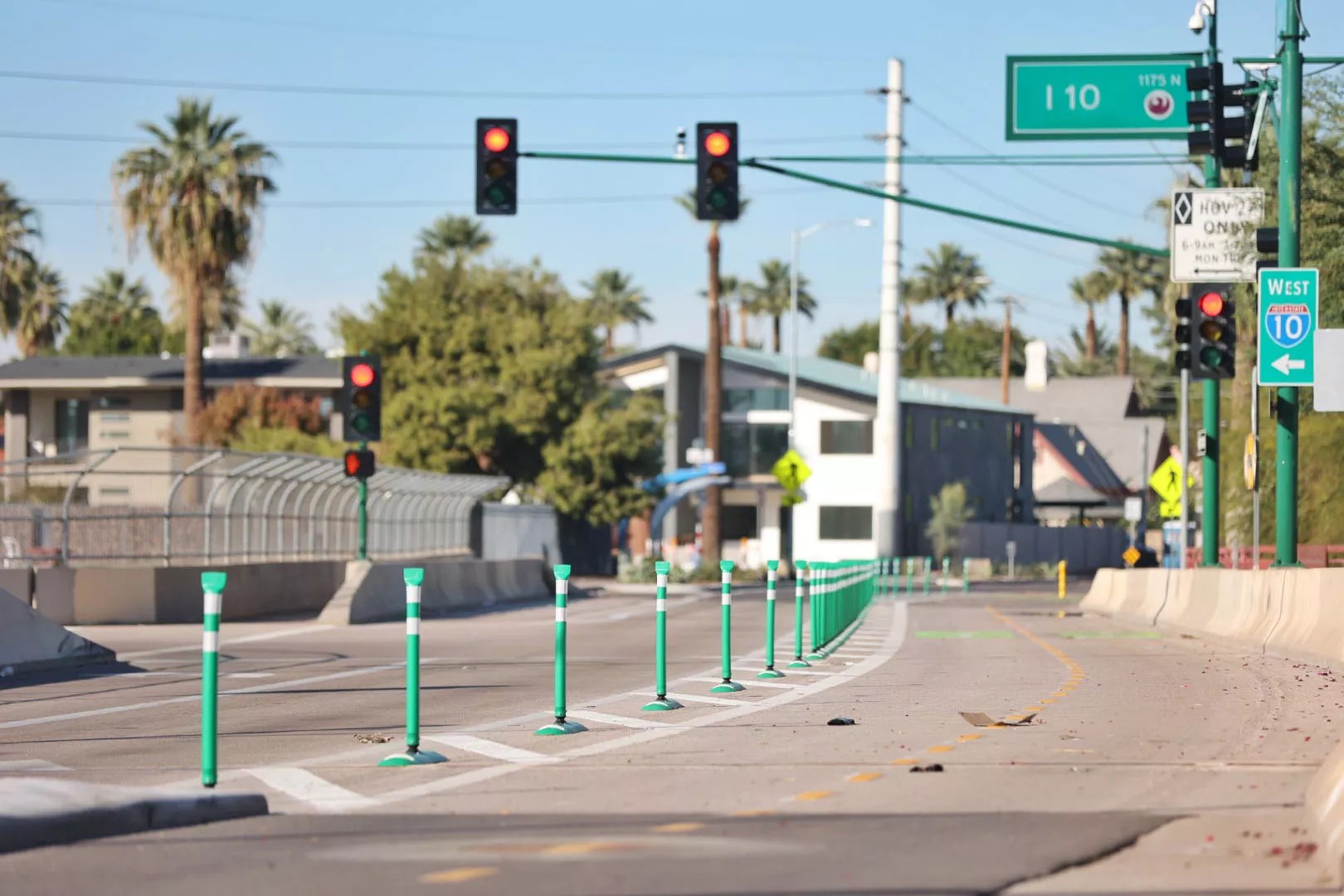
Bicyclists are still dying in the streets – most of which don’t even have painted lanes, let alone barriers.
On December 16, a cyclist was hit by a sedan while riding along McDowell Road near 34th Street in Phoenix. Jeffrey Ray, 53, died later that night.
Phoenix police charged 18-year-old Javon Holston with a felony hit-and-run for leaving the scene of the crash. That’s not the kind of justice advocates want.
From hobbyists to street racers, there are tens of thousands of cyclists on the roads in Phoenix, with USA Cycling (USAC) hosting dozens of events in Phoenix every year.
Phoenix City Council approved $4.5 million for a pedestrian safety plan to target dangerous intersections such as Sixteenth Street and Camelback Road, Nineteenth and Southern avenues, and 75th Avenue and Indian School Road.
“Many new cars also have advanced technologies that automatically brake when they sense another vehicle, pedestrian, or an object may be too close – buffers like these would provide an added signal for action,” Ansari, the councilmember said.

Despite physical barriers to keep vehicles and bicycles separated on the roadways, some damage was done to a barrier in Phoenix.
Jacob Tyler Dunn
Improving pedestrian safety downtown is the harbinger of a bicycle and pedestrian-friendly city. Regional safety plans are in the works, she said. The city collects data to measure the impact of safety efforts and councilmember Ansari is alerted with a text message whenever there’s a high-profile crash in the city.
Boyd sees Hughes’ untimely death as a catalyst in improving pedestrian safety in Phoenix. Downtown is supposed to be the most walkable and bicycle-friendly area of the city but community support after the cyclists’ death fast-tracked the project.
“This was not even on the books until the community raised the flag and said we need to have this happen,” Boyd said. “To the credit of city staff, they expedited this. They made it happen because they knew we were all up in arms.”